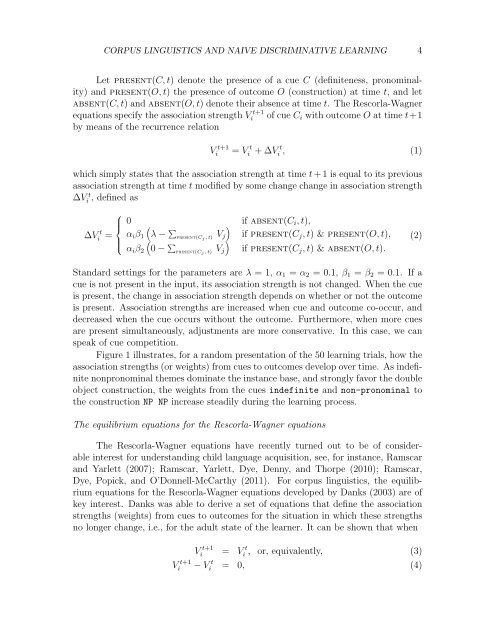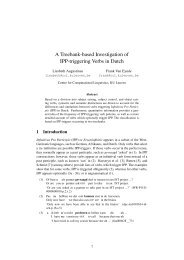Corpus linguistics and naive discriminative learning - University of ...
Corpus linguistics and naive discriminative learning - University of ...
Corpus linguistics and naive discriminative learning - University of ...
Create successful ePaper yourself
Turn your PDF publications into a flip-book with our unique Google optimized e-Paper software.
CORPUS LINGUISTICS AND NAIVE DISCRIMINATIVE LEARNING 4<br />
Let present(C, t) denote the presence <strong>of</strong> a cue C (definiteness, pronominality)<br />
<strong>and</strong> present(O, t) the presence <strong>of</strong> outcome O (construction) at time t, <strong>and</strong> let<br />
absent(C, t) <strong>and</strong> absent(O, t) denote their absence at time t. The Rescorla-Wagner<br />
equations specify the association strength Vi t+1 <strong>of</strong> cue C i with outcome O at time t+1<br />
by means <strong>of</strong> the recurrence relation<br />
V t+1<br />
i<br />
= V t<br />
i + ∆V t<br />
i , (1)<br />
which simply states that the association strength at time t + 1 is equal to its previous<br />
association strength at time t modified by some change change in association strength<br />
∆Vi t , defined as<br />
⎧<br />
⎪⎨<br />
∆Vi t =<br />
⎪⎩<br />
0 ( if absent(C i , t),<br />
∑<br />
)<br />
α i β 1 λ −<br />
present(C j , t)<br />
V j if present(C j , t) & present(O, t),<br />
( ∑<br />
)<br />
α i β 2 0 −<br />
present(C j , t)<br />
V j if present(C j , t) & absent(O, t).<br />
St<strong>and</strong>ard settings for the parameters are λ = 1, α 1 = α 2 = 0.1, β 1 = β 2 = 0.1. If a<br />
cue is not present in the input, its association strength is not changed. When the cue<br />
is present, the change in association strength depends on whether or not the outcome<br />
is present. Association strengths are increased when cue <strong>and</strong> outcome co-occur, <strong>and</strong><br />
decreased when the cue occurs without the outcome. Furthermore, when more cues<br />
are present simultaneously, adjustments are more conservative. In this case, we can<br />
speak <strong>of</strong> cue competition.<br />
Figure 1 illustrates, for a r<strong>and</strong>om presentation <strong>of</strong> the 50 <strong>learning</strong> trials, how the<br />
association strengths (or weights) from cues to outcomes develop over time. As indefinite<br />
nonpronominal themes dominate the instance base, <strong>and</strong> strongly favor the double<br />
object construction, the weights from the cues indefinite <strong>and</strong> non-pronominal to<br />
the construction NP NP increase steadily during the <strong>learning</strong> process.<br />
The equilibrium equations for the Rescorla-Wagner equations<br />
The Rescorla-Wagner equations have recently turned out to be <strong>of</strong> considerable<br />
interest for underst<strong>and</strong>ing child language acquisition, see, for instance, Ramscar<br />
<strong>and</strong> Yarlett (2007); Ramscar, Yarlett, Dye, Denny, <strong>and</strong> Thorpe (2010); Ramscar,<br />
Dye, Popick, <strong>and</strong> O’Donnell-McCarthy (2011). For corpus <strong>linguistics</strong>, the equilibrium<br />
equations for the Rescorla-Wagner equations developed by Danks (2003) are <strong>of</strong><br />
key interest. Danks was able to derive a set <strong>of</strong> equations that define the association<br />
strengths (weights) from cues to outcomes for the situation in which these strengths<br />
no longer change, i.e., for the adult state <strong>of</strong> the learner. It can be shown that when<br />
V t+1<br />
i<br />
(2)<br />
Vi t+1 = Vi t , or, equivalently, (3)<br />
− Vi t = 0, (4)
















